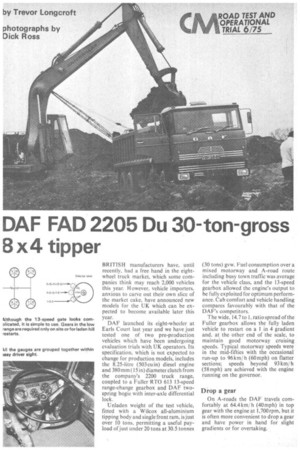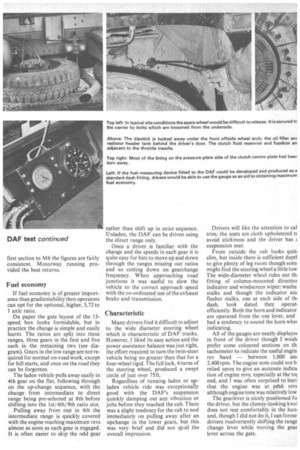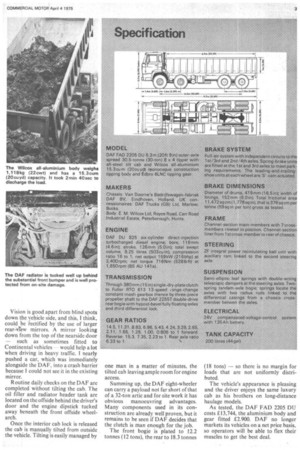DAF FAD 2205 Du 30-ton-gross x4 tipper
Page 38

Page 39

Page 40

Page 41

If you've noticed an error in this article please click here to report it so we can fix it.
BRITISH manufacturers have, until recently, had a free hand in the eightwheel truck market, which some companies think may reach 2,000 vehicles this year. However, vehicle importers, anxious to carve out their own slice of the market cake, have announced new models for the UK which can be expected to become available later this year.
DAF launched its eight-wheeler at Earls Court last year and we have just tested one of two pre-production vehicles which have been undergoing evaluation trials with UK operators. Its specification, which is not expected to change for production models, includes the 8.25-litre (503 cu in) diesel engine and 380 mm( 15 in) diameter clutch from the company's 2200 truck range, coupled to a Fuller RTO 613 13-speed range-change gearbox and DAF twospring bogie with inter-axle differential lock.
Unladen weight of the test vehicle, fitted with a Wilcox all-aluminium tipping body and single front ram, is just over 10 tons, permitting a useful payload of just under 20 tons at 30.5 tonnes (30 tons) gvw. Fuel consumption over a mixed motorway and A-road route including busy town traffic was average for the vehicle class, and the 13-speed gearbox allowed the engine's output to be fully exploited for optimum performance. Cab comfort and vehicle handling compares favourably with that of the DAF's competitors.
The wide, 14.7 to I, ratio spread of the Fuller gearbox allows the fully laden vehicle to restart on a I in 4 gradient and, at the other end of the scale, to maintain good motorway cruising speeds. Typical motorway speeds were in the mid-fifties with the occasional run-up to 96 km/ h (60 mph) on flatter sections; speeds beyond 93 km/ h (58 mph) are achieved with the engine running on the governor.
Drop a gear
On A-roads the DAF travels comfortably at 64.4 km/ h (40mph) in top gear with the engine at 1,700 rpm, but it is often more convenient to drop a gear and have power in hand for slight gradients or for overtaking. The differential lock was used once to pull the vehicle from the site immediately after tipping. While discharging the load the bogie wheels sank into deep clay and the lock was engaged for a clean restart from the troughs that had formed around the wheels.
Controls for the tipping gear are mounted just to the left of the driver's seat and behind the park brake; optimum tipping speeds are achieved with the engine at around 1.200 rpm. At normal pace and including the release and re-fastening of the tailgate, the tipping operation takes 2 min 40sec.
Apart from restarting on a I in 4 gradient the DAF showed a clean pair of heels on a straight climb up the 1 in 3 test gradient at the MIRA proving grounds. However, on the first attempt at the climb the clutch on the DAF gave out for no apparent reason. In fact, the vehicle had not reached the incline but was running down the slight dip on the gradient approach.
The vehicle was picked up by S.W. Services (Midlands) Ltd, the Birmingham-based DAF distributor, and towed to its depot where the faulty unit was replaced overnight.
First impressions were that the clutch withdrawal mechanism had failed, but later inspection showed that practically all of lining from the pressure plate side of the centre plate had been torn away from its fixings. DAF Trucks (GB) Ltd has so far been unable to explain the cause of failure, but pointed out that the vehicle had been abused during evaluation. The vehicle had covered nearly 30,571 km (19,000 miles) when the clutch failed.
The clutch has been returned to the parent company in Holland and a further report will be published in CM later on.
Although the 380 mm (15 in) diameter clutch is common to the DAF 2200 truck range, which is designed for operation at up to 36.5 tonnes (36 tons) it would seem that a heavier-duty unit' may be required to take the greater shock loadings inherent in tipper opera tion or the failure may just have been one of those freak happenings.
Braking tests were completed at the MIRA proving grounds on a surface mottled with damp patches. Only one of the axles locked up under full pressure when stopping from 64.4 km/ h (40 mph) and the results achieved were satisfactory. The park brake held the laden vehicle in both directions on a I in 4 slope.
The road section of the test ran southward from Birmingham via M6, A444 and A5 to the MIRA proving grounds near Nuneaton and then via A5, Ml, A405 and M/ A40 to the DAF Trucks (GB) Ltd headquarters at Marlow, Bucks. Overall consumption was 2.4 km/ I (6.9mpg) and except for the first section to M6 the figures are fairly consistent. Motorway running provided the best returns.
Fuel economy
If fuel economy is of greater importance than gradientability then operators can opt for the optional, higher, 5,72 to 1 axle ratio.
On paper the gate layout of the l3speed box looks formidable, but in practice the change is simple and easily learnt. The ratios are split into three ranges, three gears in the first and five each in the remaining two (see diagram). Gears in the low range are not required for normal on-road work, except for hill starts, and once on the road they can be forgotten.
The laden vehicle pulls away easily in 4th gear on the flat, following through on the up-change sequence, with the change from intermediate to direct range being pre-selected at 8th before shifting into the 1st/ 4th/ 9th ratio slot.
Pulling away from rest in 4th the intermediate range is quickly covered with the engine reaching maximum revs almost as soon as each gear is engaged. It is often easier to skip the odd gear rather than shift up in strict sequence. Unladen, the DAF can be driven using the direct range only.
Once a driver is familiar with the change and the speeds in each gear it is quite easy for him to move up and down through the ranges missing out ratios and so cutting down on gearchange frequency. When approaching road junctions it was useful to slow the vehicle to the correct approach speed with the co-ordinated use of the exhaust brake and transmission.
Characteristic
Many drivers find it difficult to adjust to the wide diameter steering wheel which is characteristic of DAF trucks. However, I liked its easy action and the power assistance balance was just right, the effort required to turn the twin-steer vehicle being no greater than that for a four-wheel rigid. The full lock, 4 turns of the steering wheel, produced a swept circle of just over 75ft.
Regardless of running laden or upladen vehicle ride was exceptionally good with the DAF's suspension quickly damping out any vibration or jolts before they reached the cab. There was a slight tendency for the cab to nod immediately on pulling away after an upchange in the lower gears, but this was very brief and did not spoil the overall impression. Drivers will like the attention to cal trim; the seats are cloth upholstered tt avoid stickiness and the driver has suspension seat.
From outside the cab looks quit( slim, but inside there is sufficient deptl to give plenty of leg room though somi might find the steering wheel a little low The wide-diameter wheel rules out till fitting of column-mounted directioi indicator and windscreen wiper/ washe stalks and though the indicator an( flasher stalks, one at each side of ail dash, look dated they operati efficiently. Both the horn and indicator are operated from the one lever, and had a tendency to sound the horn whel indicating.
All of the gauges are neatly displaye( in front of the driver though I woul( prefer some coloured sections on th, tachometer to indicate the useful engin, rev band between 1,800 am 2,400 rpm. The engine note could not b, relied upon to give an accurate indica tion of engine revs, especially at the to] end, and 1 was often surprised to lean that the engine was at peak revs although engine tone was relatively low The gearlever is nicely positioned fo the driver, but the clumsy-looking knol does not rest comfortably in the ham and, though I did not do it, I can forese drivers inadvertently shifting the range change lever while moving the gear lever across the gate. Vision is good apart from blind spots down the vehicle side, and this, I think, could be iectified by the use of larger rear-vtew mirrors. A mirror looking down from the top of the nearside door — such as sometimes fitted to Continental vehicles would help a lot when driving in heavy traffic. I nearly pushed a car, which was immediately alongside the DAF, into a crash barrier because I could not see it in the existing mirror.
Routine daily checks on the DAF are completed without tilting the cab. The oil filler and radiator header tank are located on the offside behind the driver's door and the engine dipstick tucked away beneath the front offside wheelarch.
Once the interior cab lock is released the cab is manually tilted from outside the vehicle. Tilting is easily managed by one man in a matter of minutes, the tilted cab leaving ample room for engine access.
Summing up, the DAF eight-wheeler can carry a payload not far short of that of a 32-ton artic and for site work it has obvious manoeuvring advantages. Many components used in its construction are already well proven, but it remains to be seen if DAF decides that the clutch is man enough for the job.
The front bogie is plated to 12.2 tonnes (12 tons), the rear to 18.3 tonnes (18 tons) — so there is no margin for loads that are not uniformly distributed.
The vehicle's appearance is pleasing and the driver enjoys the same luxury cab as his brothers on long-distance haulage models.
As tested, the DAF FAD 2205 DU costs £13,744, the aluminium body and gear fitted £.2.900. DAF no longer markets its vehicles on a net price basis, so operators will be able to flex their muscles to get the best deal.




































































































